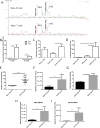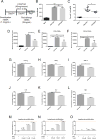Production of endocannabinoids by activated T cells and B cells modulates inflammation associated with delayed-type hypersensitivity
- PMID: 27064137
- PMCID: PMC5206973
- DOI: 10.1002/eji.201546181
Production of endocannabinoids by activated T cells and B cells modulates inflammation associated with delayed-type hypersensitivity
Abstract
Endocannabinoids are endogenous ligands for the cannabinoid (CB) receptors which include anandamide (AEA) and 2-arachidonyl glycerol (2-AG). 2-AG has been linked to inflammation due to its elevated expression in animal models of autoimmunity and hypersensitivity. However, administration of exogenous 2-AG has been shown to suppress inflammation making its precise role unclear. In the current study, we investigated the role of 2-AG following immunization of C57BL/6 (BL6) mice with methylated BSA (mBSA) antigen, which triggers both delayed-type hypersensitivity (DTH) and antibody response. We found that while naïve T cells and B cells expressed low levels of 2-AG, expression significantly increased upon activation. Furthermore, mBSA-immunized mice exhibited higher 2-AG concentration than naïve mice. Exogenous 2-AG treatment (40 mg/kg) in mBSA-immunized mice led to reduced DTH response, and decreased Th1 and Th17-associated cytokines including IL-6, IL-2, TNF-α, and the IgG response. Addition of 2-AG to activated popliteal lymph node (PopLN) cell cultures also inhibited lymphocyte proliferation. Together, these data show for the first time that activated T and B cells produce 2-AG, which plays a negative regulatory role to decrease DTH via inhibition of T-cell activation and proliferation. Moreover, these findings suggest that exogenous 2-AG treatment can be used therapeutically in Th1- or Th17-driven disease.
Keywords: Anti-inflammatory; Cannabinoid receptor; Delayed-type hypersensitivity (DTH); Endocannabinoids; Th1; Th17; T cell suppression.
© 2016 WILEY-VCH Verlag GmbH & Co. KGaA, Weinheim.
Conflict of interest statement
The authors declare no commercial or finical conflict of interest.
Figures



Similar articles
-
Anandamide attenuates Th-17 cell-mediated delayed-type hypersensitivity response by triggering IL-10 production and consequent microRNA induction.PLoS One. 2014 Apr 3;9(4):e93954. doi: 10.1371/journal.pone.0093954. eCollection 2014. PLoS One. 2014. PMID: 24699635 Free PMC article.
-
Marijuana-derived Δ-9-tetrahydrocannabinol suppresses Th1/Th17 cell-mediated delayed-type hypersensitivity through microRNA regulation.J Mol Med (Berl). 2016 Sep;94(9):1039-51. doi: 10.1007/s00109-016-1404-5. Epub 2016 Apr 1. J Mol Med (Berl). 2016. PMID: 27038180 Free PMC article.
-
A COX-2 metabolite of the endogenous cannabinoid, 2-arachidonyl glycerol, mediates suppression of IL-2 secretion in activated Jurkat T cells.Biochem Pharmacol. 2008 Aug 1;76(3):353-61. doi: 10.1016/j.bcp.2008.05.005. Epub 2008 May 9. Biochem Pharmacol. 2008. PMID: 18571623
-
Biochemistry, pharmacology and physiology of 2-arachidonoylglycerol, an endogenous cannabinoid receptor ligand.Prog Lipid Res. 2006 Sep;45(5):405-46. doi: 10.1016/j.plipres.2006.03.003. Epub 2006 Apr 19. Prog Lipid Res. 2006. PMID: 16678907 Review.
-
Endocannabinoids and endocannabinoid-related mediators: Targets, metabolism and role in neurological disorders.Prog Lipid Res. 2016 Apr;62:107-28. doi: 10.1016/j.plipres.2016.02.002. Epub 2016 Mar 7. Prog Lipid Res. 2016. PMID: 26965148 Review.
Cited by
-
Impact of Δ9-Tetrahydrocannabinol on Rheumatoid Arthritis Synovial Fibroblasts Alone and in Co-Culture with Peripheral Blood Mononuclear Cells.Biomedicines. 2022 May 11;10(5):1118. doi: 10.3390/biomedicines10051118. Biomedicines. 2022. PMID: 35625855 Free PMC article.
-
Circulating Endocannabinoids: From Whence Do They Come and Where are They Going?Neuropsychopharmacology. 2018 Jan;43(1):155-172. doi: 10.1038/npp.2017.130. Epub 2017 Jun 27. Neuropsychopharmacology. 2018. PMID: 28653665 Free PMC article. Review.
-
Inflammation and Nitro-oxidative Stress as Drivers of Endocannabinoid System Aberrations in Mood Disorders and Schizophrenia.Mol Neurobiol. 2022 Jun;59(6):3485-3503. doi: 10.1007/s12035-022-02800-y. Epub 2022 Mar 26. Mol Neurobiol. 2022. PMID: 35347586 Review.
-
Interplay between cannabinoids and the neuroimmune system in migraine.J Headache Pain. 2024 Oct 16;25(1):178. doi: 10.1186/s10194-024-01883-3. J Headache Pain. 2024. PMID: 39407099 Free PMC article. Review.
-
Blockade of CB1 cannabinoid receptor alters gut microbiota and attenuates inflammation and diet-induced obesity.Sci Rep. 2017 Nov 15;7(1):15645. doi: 10.1038/s41598-017-15154-6. Sci Rep. 2017. PMID: 29142285 Free PMC article.
References
-
- Tanasescu R, Constantinescu CS. Cannabinoids and the immune system: an overview. Immunobiology. 2010;215:588–597. - PubMed
-
- Mechoulam R, Ben-Shabat S, Hanus L, Ligumsky M, Kaminski NE, Schatz AR, Gopher A, Almog S, Martin BR, Compton DR, et al. Identification of an endogenous 2-monoglyceride, present in canine gut, that binds to cannabinoid receptors. Biochem Pharmacol. 1995;50:83–90. - PubMed
-
- Sugiura T, Kondo S, Sukagawa A, Nakane S, Shinoda A, Itoh K, Yamashita A, Waku K. 2-Arachidonoylglycerol: a possible endogenous cannabinoid receptor ligand in brain. Biochem Biophys Res Commun. 1995;215:89–97. - PubMed
-
- Sugiura T, Kondo S, Kishimoto S, Miyashita T, Nakane S, Kodaka T, Suhara Y, Takayama H, Waku K. Evidence that 2-arachidonoylglycerol but not N-palmitoylethanolamine or anandamide is the physiological ligand for the cannabinoid CB2 receptor. Comparison of the agonistic activities of various cannabinoid receptor ligands in HL-60 cells. J Biol Chem. 2000;275:605–612. - PubMed
-
- Prescott SM, Majerus PW. Characterization of 1,2-diacylglycerol hydrolysis in human platelets. Demonstration of an arachidonoyl-monoacylglycerol intermediate. J Biol Chem. 1983;258:764–769. - PubMed
MeSH terms
Substances
Grants and funding
LinkOut - more resources
Full Text Sources
Other Literature Sources

